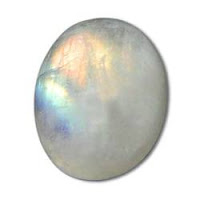The moonstone is considered as an charming play of light. Certainly it owes its name to that secretive shimmer, which always seems to be different when the stone is moved, so, it is called in the trade as ‘adularescene.’ Earlier, people considered they could identify in moonstone the falcate and fading phases of moon.
Moonstones of Sri Lanka, the origin country of moonstone, sparkle in pale blue on an almost see-through background. Specimens from India offer a nebulous interplay of shadow and light on a background of beige-brown, brown, orange, or green.
These subtle colors, in connection to the fine shimmer makes moonstone a perfect gemstone for jewelery with feminine and sensual aura. This gemstone was very famous around 100 years ago at the Art Nouveau time. It decorates a noticeably big number of jewelery creations of the French master goldsmith Rene Lalique and his generations, majorly to be found in collections and museums today.
The moonstone is surrounded by a decent deal of magic and mystique. In many cultures, for instance in India, it is known as a magical holystone. In India, moonstones are also known as ‘dream stones’ that carry the wearer beautiful visions at night. In Arabic nations, females frequently wear moonstones sewn out of sight in their garments. For their culture the moonstone is the sign of fertility.

No comments:
Post a Comment